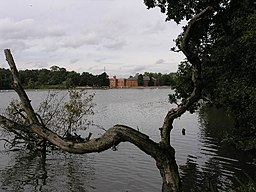Rainworth Water
| Rainworth Water | |
| River | |
|
Rufford mill and lake, which is fed by Rainworth Water
|
|
| Country | England |
|---|---|
| County | Nottinghamshire |
| Tributaries | |
| - left | Foulevil Brook |
| - right | Gallow Hole Dyke |
| Source | |
| - location | Ravenshead |
| Mouth | River Maun |
| - location | Ollerton |
Rainworth Water is a watercourse that is a tributary of the River Maun near Rainworth, Nottinghamshire, England. It is characterised by a number of lakes, including that which forms part of the country park at Rufford Abbey. L Lake at Rainworth forms part of the Rainworth Lakes Site of Special Scientific Interest. There are two designated Local Nature Reserves along its length, one of which is also known by the name Rainworth Water. The Rainworth Water LNR is owned and managed by Nottinghamshire County Council.
Rainworth Water LNR was once part of Rufford Colliery, which created the spoil heaps that form a bowl around the watercourse. The spoil heaps were restored after the colliery closure and the planting of thousands of broadleaved trees and other woodland species have stabilised the ground. The Water itself is a wetland habitat consisting of artificial pools, shallows and meanders that appear natural and support dragonflies and damselflies. Marshy areas have developed naturally alongside the watercourse since restoration, as have open grassland and dense scrubland. A colony of Dingy Skipper butterflies, which are rare within Nottinghamshire, inhabits the open grasslands.
The area was declared a Local Nature Reserve in 2005. Most maintenance work on the reserve is conducted by Nottinghamshire County Council but some is undertaken by the Friends of Tippings Wood.
The river rises in Normanshill Wood, to the north-west of Ravenshead and flows eastwards, passing under the A60 road, and to the south of Portland Training College. There are two lakes created by dams, which were once fish ponds. To the north of the second lake is Fountain Dale moat, which is known to have existed in 1251, when there was a hunting lodge on the 52-by-38-yard (48 by 35 m) island, from which tolls were collected by the forester Raffe Clerc. There is a 46-foot (14 m) wide causeway across the north-eastern corner of the moat, which is around 39 feet (12 m) wide, with a substantial bank beyond that. The site has not been disturbed since it was abandoned, and so is better preserved than many residential moated sites in Britain. To the south of the lake is the Grade II listed Fountain Dale House, dating from the mid-eighteenth and nineteenth centuries. At the outlet of the lake is a Grade II listed well head constructed of ashlar and red brick, called Friar Tuck's well, after which the river turns to the north-east to reach another artificial lake called Cave Pond. Passing under Blidworth Lane on the outskirts of Rainworth, it enters an 'L'-shaped lake, called "L Lake", the other branch of which is fed by Foulevil Brook. The main lake covers an area of 4.0 acres (1.62 ha) and is a private fishery, stocked with bream, carp, pike, roach and tench. It forms part of the Rainworth Lakes Site of Special Scientific Interest (SSSI), which covers an area of 36.2 acres (14.6 ha) and has been designated because of the variety of plant species which grow in the open water and adjacent marsh. The naturalist Joseph Whitaker lived by the lakes at Rainworth Lodge. The river passes through the centre of Rainworth village, under the B6020 and the A617 Rainworth bypass. Rainworth Sewage Treatment Works is located on its north-east bank, as is the Rainworth Water local nature reserve, after which it is culverted to pass under a railway embankment associated with Rufford Colliery. By Inkersall Manor there are ponds on both sides, where the name of the woodland, which is Damside Covert, and the presence of earthworks, suggests they were part of a larger lake at one time.
...
Wikipedia

